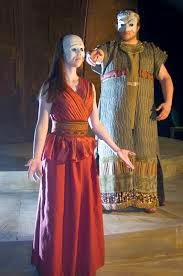Greek theatre
-
Most Greek cities had a theatre. It was in the open air, and was usually a bowl-shaped arena on a hillside. Some theatres were very big, with room for more than 15,000 people in the audience.
All the actors were men or boys. Dancers and singers, called the chorus, performed on a flat area called the orchestra. Over time, solo actors also took part, and a raised stage became part of the theatre. The actors changed costumes in a hut called the "skene". Painting the walls of the hut made the first scenery.
The plays were comedies (funny, often poking fun at rulers) or tragedies (sad and serious, with a lesson about right and wrong). https://www.youtube.com/watch?v=dmBDfl9YJY4
-
Greek actors wore masks, made from stiffened linen, with holes for eyes and mouth. Actors also wore wigs. They wore thick-soled shoes too, to make them look taller, and padded costumes to make them look fatter or stronger. The masks showed the audience what kind of character an actor was playing (sad, angry or funny). Some masks had two sides, so the actor could turn them round to suit the mood for each scene.The best actors and play writers were awarded prizes - a bit like the Hollywood Oscars and BAFTAs today. The most famous writers of plays were Aeschylus, Sophocles and Euripides fortragedy and Aristophanes for comedy.
Most Greek cities had a theatre. It was in the open air, and was usually a bowl-shaped arena on a hillside. Some theatres were very big, with room for more than 15,000 people in the audience.
All the actors were men or boys. Dancers and singers, called the chorus, performed on a flat area called the orchestra. Over time, solo actors also took part, and a raised stage became part of the theatre. The actors changed costumes in a hut called the "skene". Painting the walls of the hut made the first scenery.
The plays were comedies (funny, often poking fun at rulers) or tragedies (sad and serious, with a lesson about right and wrong). https://www.youtube.com/watch?v=dmBDfl9YJY4
Greek actors wore masks, made from stiffened linen, with holes for eyes and mouth. Actors also wore wigs. They wore thick-soled shoes too, to make them look taller, and padded costumes to make them look fatter or stronger. The masks showed the audience what kind of character an actor was playing (sad, angry or funny). Some masks had two sides, so the actor could turn them round to suit the mood for each scene.The best actors and play writers were awarded prizes - a bit like the Hollywood Oscars and BAFTAs today. The most famous writers of plays were Aeschylus, Sophocles and Euripides fortragedy and Aristophanes for comedy.
கிரேக்க நாட்டில் நாடகம் கி.மு 534 ஆம் ஆண்டளவில் தோற்றம் பெற்றது.கி.மு. பதின்மூன்றாம் நூற்றாண்டில் 'டயோனிசஸ்' வசந்தம் மற்றும் வளம் போன்றவற்றின் அடையாளமான கிரேக்க தெய்வத்தின் வழிபாடு நடைபெற்றது. பக்திப் பரவசத்தினால் பக்திப் பாடல்கள் பாடப்படும். இவ்வாடல்-பாடல்களிலிருந்தே நாடகம் பிறந்தது என கிரேக்க மேதையான அரிஸ்டாட்டில் குறிப்பிட்டுள்ளார்.
'டயோனிசஸ்' தெய்வத்திற்கு ஆண்டுக்கு மூன்று திருவிழாக்கள் நடைபெறும். டிசம்பர், ஜனவரி, மார்ச், மாதங்களில் கொண்டாடப்படும் இத்திருவிழாக்களில் மார்ச் திங்கள் நடைபெறும் திருவிழா 'குழு நடனங்களின் போட்டி' என்பதற்குப் பதிலாக, துயரக் காட்சிகளின் போட்டி' என மாற்றியமைக்கப்பட்டு நடைபெற்று வந்தது.
கிரேக்கத்தின் முதல் நாடக நடிகர் தெஸ்பிஸ் ஆவார்..
கிரேக்க நாடக அரங்குகள்
டயோனிசஸ்' தெய்வத் திருவிழாக் காலங்களில் அத்தெய்வத்தின் கோயில்களின் மேற்பகுதியில் கோட்டை போன்ற அமைப்பின் சரிவான பகுதிகள் நாடக அரங்குகளாகப் பயன்படுத்தப்பட்டது.
கிரேக்க நாட்டில் நாடகம் கி.மு 534 ஆம் ஆண்டளவில் தோற்றம் பெற்றது.கி.மு. பதின்மூன்றாம் நூற்றாண்டில் 'டயோனிசஸ்' வசந்தம் மற்றும் வளம் போன்றவற்றின் அடையாளமான கிரேக்க தெய்வத்தின் வழிபாடு நடைபெற்றது. பக்திப் பரவசத்தினால் பக்திப் பாடல்கள் பாடப்படும். இவ்வாடல்-பாடல்களிலிருந்தே நாடகம் பிறந்தது என கிரேக்க மேதையான அரிஸ்டாட்டில் குறிப்பிட்டுள்ளார்.
கி.மு. ஆறாம் நூற்றாண்டுக் காலப்பகுதியில் பார்வையாளர்கள் மலைச்சரிவுகளில் இருக்க அச்சரிவுகளின் அடிவாரத்தில் நாடக நடிகர்களின் அரங்கம் இருந்தது. காட்சிக்கான பின்னணி (திரைச்சீலை) அக்காலகட்டத்தில் இல்லையென்பதும் குறிப்பிடத்தக்கது.
காட்சி வீடு
கி.மு. ஜந்து - நான்காம் நூற்றாண்டு காலப்பகுதியில் நடனமாடும் இடம் என அழைக்கப்பெற்ற 'காட்சி வீடு' போன்ற அமைப்பிலான அரங்கம் பார்வையாளர்கள் அமருவதற்கு வசதியாக மலைகளில் கற்களால் கட்டப்பெற்றன.
'மன்னர் இடிஃபஸ்' என்ற நாடகம் அரங்கேற்றப்பட்ட வேளை இருபுறம் அமைந்த செவ்வக வடிவத்தினை உடைய கட்டிடம் பின்னணியாக அமைக்கப்பட்டது. இவ்வடிவமைப்பே பின்னாட்களில் அனைத்து நாடகங்களிலும் பயன்படுத்தப்பட்டது. ஒவ்வொரு ஆண்டும், ஒவ்வொரு நாடகத்திற்கேற்றாற்போல மாற்றி அமைக்கப்பட்டதெனவும் கருத்து நிலவுகின்றது.
திறந்த வெளி நாடகங்கள்
பெரும்பாலான கிரேக்க நாடகங்கள் திறந்த வெளியிலேயே நடந்தது. சோபகிள்ஸ்' என்பவர் படைத்த நாடகமொன்றில் மூன்று ஆண்கள் மட்டுமே பங்குபெற்று நடித்தனர். இவர்களில் சிலர் பெண் வேடமிட்டும் நடித்தனர்.கிரேக்க நாடகத்தின் வீழ்ச்சி

No comments:
Post a Comment